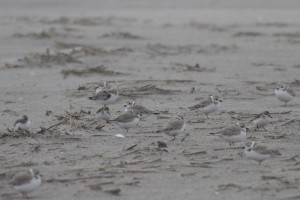HURRICANE SANDY STORM REPORT
Assessing the damage to coastal wildlife and their habitat
By Stephanie Egger, Wildlife Biologist

As we all know Hurricane Sandy caused severe damage and devastation to New Jersey residents, homes, and their businesses, but we must not forget that wildlife can also suffer from the impacts of a hurricane. CWFNJ’s Beach Nesting Bird Project Manager, Todd Pover, Alfred Breed, CWFNJ Field Technician, and myself, conducted wildlife/habitat assessments on beaches from Brigantine to Cape May after the storm. Our nesting sites further north in Ocean and Monmouth Counties were still not accessible at that time to evaluate. We assessed nesting habitat for beach nesting bird species, especially Piping Plover as well beach/inlet habitat used by migratory shorebirds, particularly American Oystercatchers.

As expected, many of our nesting sites and sites that are also used by migratory shorebirds for roosting were hit hard by Hurricane Sandy, losing a great deal of sand and suitable habitat. However, in some locations such as Stone Harbor Point and North Brigantine Natural Area, the storm scoured out areas with too much vegetation which is good for beach nesters as they prefer sparsely vegetated areas. Sand was also pushed back into the dunes to create blowouts and overwash areas that may serve as additional habitat. Many of the areas seem to be very low lying now from the loss of sand and might be more flood prone which could impact the beach nesters in the spring.
We also observed migratory songbirds, golden-crowned kinglets, which were taking shelter and flittering through the back dune/bayberry habitat right after the storm. This was a good reminder of the value of New Jersey coastal habitat for songbirds as they migrate down the coast.

As part of our assessment, we conducted American Oystercatcher surveys as a significant number use New Jersey beaches for roosting during the fall and winter. Luckily, approximately 900-1,000 American Oystercatchers were still using our southern coastal inlets after Sandy, about the same number of birds observed the week before the storm. Thanks to funding from the National Fish and Wildlife Foundation we were already conducting fall surveys for American Oystercatchers and in the position to compare their numbers before and after the storm.
Only time will tell if the habitat will build back up enough in time for the spring as the birds begin to arrive for the nesting season or if it will have lasting impacts on migratory bird species. We hope to conduct further assessments to gain a better understanding of the short- and long-term impacts to wildlife from Hurricane Sandy and how that may affect conservation and recovery effort for these species moving forward.
For CWFNJ’s videos of wildlife and habitat assessments click on the links below:
Wildlife Assessment Post Hurricane Sandy at North Brigantine Natural Area, NJ
Wildlife Assessment Post Hurricane Sandy at Stone Harbor Point, NJ
Wildlife Assessment Post Hurricane Sandy at Strathmere Natural Area, NJ


